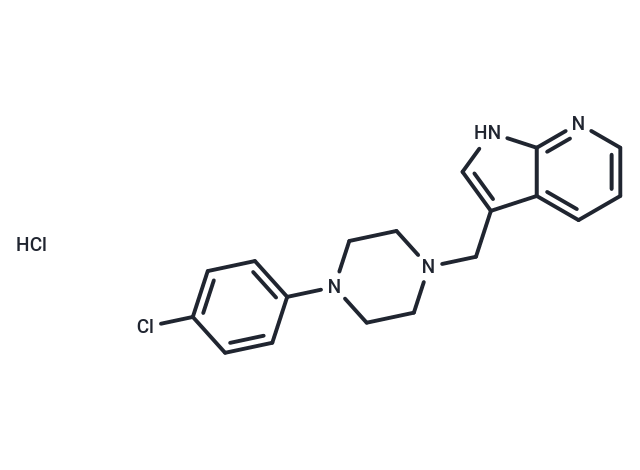Shopping Cart
- Remove All
 Your shopping cart is currently empty
Your shopping cart is currently empty

L-745870 hydrochloride has excellent brain penetration. L-745870 hydrochloride is a high-affinity, selective and orally active human dopamine D4 receptor antagonist with a Ki of 0.43 nM, and considerably weaker D2 receptor affinity with a Ki of 960 nM and D3 receptor affinity with a Ki of 2300 nM.

| Pack Size | Price | Availability | Quantity |
|---|---|---|---|
| 5 mg | $34 | In Stock | |
| 10 mg | $59 | In Stock | |
| 25 mg | $113 | In Stock | |
| 50 mg | $188 | In Stock | |
| 100 mg | $273 | In Stock | |
| 200 mg | $393 | In Stock | |
| 1 mL x 10 mM (in DMSO) | $29 | In Stock |
| Description | L-745870 hydrochloride has excellent brain penetration. L-745870 hydrochloride is a high-affinity, selective and orally active human dopamine D4 receptor antagonist with a Ki of 0.43 nM, and considerably weaker D2 receptor affinity with a Ki of 960 nM and D3 receptor affinity with a Ki of 2300 nM. |
| Targets&IC50 | D3 receptor (human):2300 nM(Ki), D4 receptor (human):0.43 nM(Ki), D2 receptor (human):960 nM(Ki) |
| In vitro | In vitro pharmacological studies revealed that L-745870 is an antagonist at human D4 receptors, in that L-745870 antagonized the ability of D4 receptors to inhibit agonist-induced stimulation of [35S]-GTPgS binding,?blocked the inhibition of forskolin-stimulated adenylate cyclase activity in transfected human embryonic kidney (HEK293) and Chinese hamster ovary (CHO) cells,?blocked dopamine-induced inhibition of Ca2+ currents in transfected GH4C1 pituitary cells,?inhibited D4 activation of cloned G protein-coupled inwardly rectifying K+ channels,?and antagonized dopamine-induced stimulation of extracellular acidification in transfected cells[1]. |
| In vivo | L-745870 exhibits favorable pharmacokinetic properties (20-60% oral bioavailability and plasma t1/2 of 2.1-2.8 hours) in both rats and monkeys, with excellent brain penetration and high brain-to-plasma ratios in rats[1]. Evaluation of L-745870 in surrogate marker assays indicates that it is readily available for biological activity in the brain and at doses of 5 to 60 mg/kg p.o., it would occupy 50% of D4 receptors in the brain. L-745870 does not affect apomorphine-induced stereotypy in rats but induces catalepsy in mice at a high dose of 100 mg/kg p.o., likely due to D2 receptor occupancy. Higher doses of L-745870 are anticipated to cause extrapyramidal symptoms in primates as these CNS levels would antagonize D2 receptors. In squirrel monkeys, L-745870 (10 mg/kg p.o.) induces mild sedation and at 30 mg/kg, it causes noticeable extrapyramidal motor symptoms, notably bradykinesia[1]. |
| Molecular Weight | 363.28 |
| Formula | C18H20Cl2N4 |
| Cas No. | 1173023-36-3 |
| Smiles | Cl.Clc1ccc(cc1)N1CCN(Cc2c[nH]c3ncccc23)CC1 |
| Relative Density. | no data available |
| Storage | Powder: -20°C for 3 years | In solvent: -80°C for 1 year | Shipping with blue ice. | ||||||||||||||||||||||||||||||||||||||||
| Solubility Information | DMSO: 55 mg/mL (151.4 mM), Sonication is recommended. 0.1 M HCL: 20 mg/mL (55.05 mM), when pH is adjusted to 3 with HCl. Sonication is recommended. | ||||||||||||||||||||||||||||||||||||||||
Solution Preparation Table | |||||||||||||||||||||||||||||||||||||||||
0.1 M HCL/DMSO
DMSO
| |||||||||||||||||||||||||||||||||||||||||

Copyright © 2015-2025 TargetMol Chemicals Inc. All Rights Reserved.